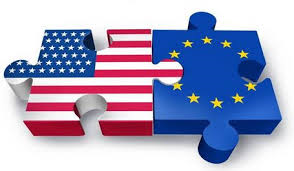Dr. Elaine Fahey, Senior Lecturer, The City Law School, City University London
The script
The EU and US have concluded six rounds of discussions on the Transatlantic Trade and Investment Agreement (TTIP). This agreement aims to reduce trade barriers and other obstacles, such as differing regulations and standards, across various industries. TTIP is promoted as potentially setting a global trade standard. Some argue it’s already irrelevant, but while this downplays its potential influence, skepticism is understandable. At times, it has seemed like an unusual experiment in rule-making.[1] TTIP seeks to evolve into a dynamic regulatory force. However, it has drawn controversy over its lack of transparency, the potential inclusion of the Investor Settlement Dispute Mechanism (ISDM), and its potential impact on EU regulatory standards. Some have even attempted, unsuccessfully, to halt the negotiations using EU law through a European Citizens Initiative.
Transatlantic relations are marked by unsuccessful attempts to harmonize EU and US legal systems through mutual recognition, even in narrow areas. TTIP seemed poised to change this pattern, becoming an exercise in ‘really responsive rule-making.’ Nevertheless, many questions linger about international negotiations and the nature of ‘really responsive EU rule-making.’ This piece will examine the agreement’s framework, its development process, and the key players involved.
The production process
Historically, most EU-US rule-making happened behind closed doors in obscure ‘Dialogues’ that primarily benefited industry. The TTIP negotiations, however, have signified a major shift in this process.
Outwardly, the TTIP negotiations have been relatively transparent. They feature an active EU TTIP Twitter account (@EU_TTIP), RSS feeds, live-streamed meetings, extensive public consultations, and a significant amount of publicly available documentation—more than even its strongest critics might acknowledge. The EU has often presented itself as a champion of transparency, contrasting with the US’s more guarded approach, even tweeting about its own transparency efforts or sharing images of public consultations and meetings. Despite this, the TTIP negotiation mandate and draft text, along with official information, have been consistently leaked and published in respected German newspapers like Die Zeit and on websites dedicated to whistleblowing like http://eu-secretdeals.info/ttip/). These leaks have threatened to undermine the EU’s efforts toward openness.
The Ombudsman recently questioned the true level of transparency in the negotiations, launching a public consultation. However, this action seems inadequate and overdue. Several key 2014 rulings from the Court of Justice of the European Union on transparency (in’t Veld, Mastercard; see previous blog entries on these cases here and here) have not sufficiently addressed the lack of access to information surrounding international relations. The leak of the EU-Canada free trade agreement (CETA) by the German broadcaster ARD this past August further highlights the questionable state of openness, international negotiations, and the EU.
The cast of actors
Faced with intense public scrutiny of TTIP, the Commission’s response has been to create more channels for dialogue with civil society, like advisory bodies, and to conduct a multitude of consultations. These efforts have yielded mixed results. For instance, although the ISDM received nearly 150,000 public comments, the content of over half remains unknown. This suggests that civil society’s role in the TTIP negotiations has become somewhat unwieldy.
The incoming Trade Commissioner Malmstrom has faced criticism for her contradictory stance on the inclusion of the ISDM in TTIP. Her responses to the issue have raised concerns about the inconsistent nature of the policy agenda under the guise of ‘really responsive rule-making.’
There is considerable room for improvement in making rule-making genuinely responsive. This could include more robust institutional dialogue and increased parliamentary involvement at both national and EU levels. The European Parliament’s authority to ratify any final agreement is seen as both a safeguard and a potential tool for those skeptical of the project. Many are examining its potential role within a dynamic regulatory framework.[2] However, the sheer scope of the rule-making endeavor might necessitate a reassessment. The newly elected Parliament needs to overcome a substantial information deficit and take control of the data to have any real influence on the negotiations.
The issue of data transfer within TTIP has been marked by constant shifts—from the NSA scandal to the Google decision, to Microsoft’s choice to relocate cloud computing and adhere to EU law. Yet, this critical issue risks being overshadowed within the broader TTIP framework. TTIP negotiators face the challenge of responding effectively to this dynamic situation and determining whether the European Parliament and Congress, each diverse in its own right, will ultimately accept the agreement.
Conflict is often intensified when the stakes are low. EU-US trade relations have never been more liberalized or mutually responsive, which adds a layer of complexity to understanding the true implications. The extent to which these negotiations can and should be ‘really responsive’ remains a point of contention, with both legal and political obstacles to overcome.
Editor’s note: This blog post was previously published on the eutopia blog; thanks for permitting it to be reblogged here.
Barnard & Peers: chapter 3, chapter 24
[1]See E. Fahey & M. Bartl ‘A Postnational Marketplace: Negotiating the Transatlantic Trade and Investment Partnership (TTIP)’ in E. Fahey & D. Curtin (Eds.),A Transatlantic Community of Law: Legal Perspectives on the Relationship between the EU and US legal orders (Cambridge: Cambridge University Press, 2014).
[2] Parker, Richard W. and Alemanno, Alberto, Towards Effective Regulatory Cooperation Under TTIP: A Comparative Overview of the EU and US Legislative and Regulatory Systems (May 15, 2014). European Commission, Brussels, May 2014. Available at SSRN: http://ssrn.com/abstract=2438242.
